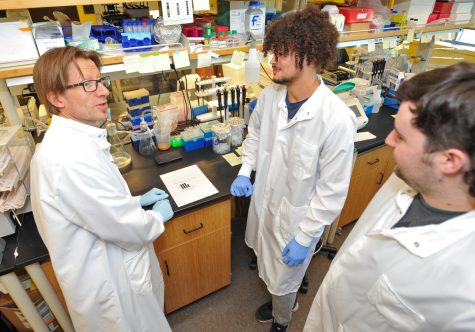Research lab explores adding more calcium, vitamin D in ice cream
40% of Americans lack calcium
Increasing calcium bioavailability in ice cream allows people to get essential nutrients, even while having a treat.
January 27, 2022
WSU researchers are investigating how to enhance calcium bioavailability in ice cream formula.
There is already calcium in the milk used for ice cream, but researchers want to improve the bioavailability of calcium by adding more of it, said Minto Michael, lead researcher and assistant professor of dairy science for the School of Food Science.
“In the U.S., we have about 40% [of the] population that does get enough calcium in their regular diet,” Michael said. “So if we try to supplement our foods that have better calcium bioavailability, it’s good for the population.”
He said his team also wants to add vitamin D to the formula because it is a major component aiding in calcium absorption.
Michael said his team chose ice cream because it is one of America’s favorite desserts. Additionally, the team wants to make ice cream a “functional food” — a food with components that provide health benefits.
“Nowadays, we are trying to see products with high sugar and fat as unhealthy,” he said. “So [we’re] trying to add some functional properties to the ice cream where people … get some health benefits.”
While the primary function of the research is increasing calcium bioavailability, secondary functions include reducing sugar and fat, and adding probiotics. However, Michael said ice cream needs to have a minimum of 10% milk fat in order to be called ice cream, as regulated by federal guidelines.
“As food scientists, we are trying to develop lots of functional foods … so that people can get as many nutrients as possible naturally rather than having to get supplements,” he said.
The research is still at an early stage, but Michael said the project will take around one year to complete.
“We’ve already done some preliminary research on current things that are already used and have been looked at in research, and we’re gonna try to apply them to ice cream. Most of them have been applied to milk,” said Phoebe Unger, doctoral student for the school of food science.
One proposed method of increasing calcium in ice cream is to include a calcium-rich diet in cows. However, Michael said his team is instead trying to find a way to add calcium into the milk directly.
“We’re gonna come up with a few strategies of adding calcium to the ice cream mix and try to study which strategy is going to be the best,” he said.
The team is also trying to figure out what method to use for chemical analysis in the lab to prove whether bioavailability is improving.
Michael said he and his team have partnered with Empowered Startup — a Canadian company that will take the research, develop the idea and work with entrepreneurs to release it commercially.
While it is uncertain which countries will be selling the ice cream, he said it will definitely be introduced in the U.S., where the research is focused.

















